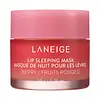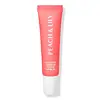What's inside
What's inside
 Key Ingredients
Key Ingredients

 Benefits
Benefits

 Concerns
Concerns

 Ingredients Side-by-side
Ingredients Side-by-side

Diisostearyl Malate
EmollientHydrogenated Polyisobutene
EmollientPhytosteryl/Isostearyl/Cetyl/Stearyl/Behenyl Dimer Dilinoleate
Skin ConditioningHydrogenated Poly(C6-14 Olefin)
EmollientPolybutene
Microcrystalline Wax
Emulsion StabilisingButyrospermum Parkii Butter
Skin ConditioningSynthetic Wax
AbrasiveEthylene/Propylene/Styrene Copolymer
Sucrose Tetrastearate Triacetate
EmollientMica
Cosmetic ColorantEuphorbia Cerifera Wax
Candelilla Wax Esters
Astrocaryum Murumuru Seed Butter
EmollientCI 77891
Cosmetic ColorantParfum
MaskingGlyceryl Caprylate
EmollientPolyglyceryl-2 Diisostearate
EmulsifyingButylene/Ethylene/Styrene Copolymer
Copernicia Cerifera Wax
Methicone
EmollientPolyglyceryl-2 Triisostearate
EmulsifyingCocos Nucifera Oil
MaskingCI 15985
Cosmetic ColorantPentaerythrityl Tetra-Di-T-Butyl Hydroxyhydrocinnamate
AntioxidantCI 15850
Cosmetic ColorantAscorbic Acid
AntioxidantWater
Skin ConditioningGlycerin
HumectantPropanediol
SolventBHT
AntioxidantPunica Granatum Fruit Juice
MaskingRubus Idaeus Juice
AstringentVitis Vinifera Juice
AntioxidantDiisostearyl Malate, Hydrogenated Polyisobutene, Phytosteryl/Isostearyl/Cetyl/Stearyl/Behenyl Dimer Dilinoleate, Hydrogenated Poly(C6-14 Olefin), Polybutene, Microcrystalline Wax, Butyrospermum Parkii Butter, Synthetic Wax, Ethylene/Propylene/Styrene Copolymer, Sucrose Tetrastearate Triacetate, Mica, Euphorbia Cerifera Wax, Candelilla Wax Esters, Astrocaryum Murumuru Seed Butter, CI 77891, Parfum, Glyceryl Caprylate, Polyglyceryl-2 Diisostearate, Butylene/Ethylene/Styrene Copolymer, Copernicia Cerifera Wax, Methicone, Polyglyceryl-2 Triisostearate, Cocos Nucifera Oil, CI 15985, Pentaerythrityl Tetra-Di-T-Butyl Hydroxyhydrocinnamate, CI 15850, Ascorbic Acid, Water, Glycerin, Propanediol, BHT, Punica Granatum Fruit Juice, Rubus Idaeus Juice, Vitis Vinifera Juice
Polyisobutene
Diisostearyl Malate
EmollientHydrogenated Polyisobutene
EmollientButyrospermum Parkii Butter
Skin ConditioningPolyglyceryl-2 Triisostearate
EmulsifyingMicrocrystalline Wax
Emulsion StabilisingOctyldodecanol
EmollientPhytosteryl/Isostearyl/Cetyl/Stearyl/Behenyl Dimer Dilinoleate
Skin ConditioningTribehenin
EmollientSynthetic Wax
AbrasiveSqualane
EmollientCollagen Extract
Skin ConditioningPolyglutamic Acid
Skin ConditioningSodium Hyaluronate
HumectantHydrolyzed Sodium Hyaluronate
Skin ConditioningHyaluronic Acid
HumectantHydrolyzed Hyaluronic Acid
HumectantWater
Skin ConditioningGlycerin
HumectantVitis Vinifera Seed Oil
EmollientSimmondsia Chinensis Seed Oil
EmollientCamellia Japonica Seed Oil
EmollientCeramide Ns
Skin ConditioningCeramide NP
Skin ConditioningCeramide AP
Skin ConditioningCeramide As
Skin ConditioningCeramide EOP
Skin ConditioningTremella Fuciformis Polysaccharide
Emulsion StabilisingChlorella Ferment
Skin ConditioningBisabolol
MaskingButylene Glycol
HumectantPrunus Persica Fruit Extract
AbrasivePalmitoyl Tripeptide-1
Skin ConditioningCopper Tripeptide-1
Skin ConditioningHexapeptide-9
Skin ConditioningAcetyl Hexapeptide-8
HumectantAcetyl Tetrapeptide-5
HumectantPalmitoyl Pentapeptide-4
Skin ConditioningDipeptide-2
Skin ConditioningNonapeptide-1
Skin ConditioningTripeptide-1
Skin ConditioningPerilla Ocymoides Leaf Extract
TonicSodium Hyaluronate Crosspolymer
HumectantEthylhexylglycerin
Skin ConditioningAdansonia Digitata Seed Oil
EmollientHippophae Rhamnoides Fruit Oil
Skin ProtectingCalophyllum Inophyllum Seed Oil
AntimicrobialStevioside
MaskingHibiscus Rosa-Sinensis Flower Extract
Humectant1,2-Hexanediol
Skin ConditioningAllantoin
Skin ConditioningCaprylic/Capric Triglyceride
MaskingTocopherol
AntioxidantDisteardimonium Hectorite
StabilisingGlyceryl Caprylate
EmollientPolyglyceryl-10 Oleate
Skin ConditioningHydrogenated Lecithin
EmulsifyingCaprylyl Glycol
EmollientPentylene Glycol
Skin ConditioningPolyisobutene, Diisostearyl Malate, Hydrogenated Polyisobutene, Butyrospermum Parkii Butter, Polyglyceryl-2 Triisostearate, Microcrystalline Wax, Octyldodecanol, Phytosteryl/Isostearyl/Cetyl/Stearyl/Behenyl Dimer Dilinoleate, Tribehenin, Synthetic Wax, Squalane, Collagen Extract, Polyglutamic Acid, Sodium Hyaluronate, Hydrolyzed Sodium Hyaluronate, Hyaluronic Acid, Hydrolyzed Hyaluronic Acid, Water, Glycerin, Vitis Vinifera Seed Oil, Simmondsia Chinensis Seed Oil, Camellia Japonica Seed Oil, Ceramide Ns, Ceramide NP, Ceramide AP, Ceramide As, Ceramide EOP, Tremella Fuciformis Polysaccharide, Chlorella Ferment, Bisabolol, Butylene Glycol, Prunus Persica Fruit Extract, Palmitoyl Tripeptide-1, Copper Tripeptide-1, Hexapeptide-9, Acetyl Hexapeptide-8, Acetyl Tetrapeptide-5, Palmitoyl Pentapeptide-4, Dipeptide-2, Nonapeptide-1, Tripeptide-1, Perilla Ocymoides Leaf Extract, Sodium Hyaluronate Crosspolymer, Ethylhexylglycerin, Adansonia Digitata Seed Oil, Hippophae Rhamnoides Fruit Oil, Calophyllum Inophyllum Seed Oil, Stevioside, Hibiscus Rosa-Sinensis Flower Extract, 1,2-Hexanediol, Allantoin, Caprylic/Capric Triglyceride, Tocopherol, Disteardimonium Hectorite, Glyceryl Caprylate, Polyglyceryl-10 Oleate, Hydrogenated Lecithin, Caprylyl Glycol, Pentylene Glycol
 Reviews
Reviews

Ingredients Explained
These ingredients are found in both products.
Ingredients higher up in an ingredient list are typically present in a larger amount.
This ingredient is also known as shea butter. It is an effective skin hydrator and emollient.
Emollients help soothe and soften your skin. It does this by creating a protective film on your skin. This barrier helps trap moisture and keeps your skin hydrated. Emollients may be effective at treating dry or itchy skin.
Shea butter is rich in antioxidants. Antioxidants help fight free-radicals, or molecules that may harm the body. It is also full of fatty acids including stearic acid and linoleic acid. These acids help replenish the skin and keep skin moisturized.
While Shea Butter has an SPF rating of about 3-4, it is not a sunscreen replacement.
Shea butter may not be fungal acne safe. We recommend speaking with a professional if you have any concerns.
Learn more about Butyrospermum Parkii ButterDiisostearyl Malate is an emollient and most often used in lip products. It comes from isostearyl alcohol, a fatty acid, and malic acid, an AHA.
As an emollient, Diisostearyl Malate helps create a thin film on your skin to trap moisture in. This helps keep your skin soft and smooth.
Glycerin is already naturally found in your skin. It helps moisturize and protect your skin.
A study from 2016 found glycerin to be more effective as a humectant than AHAs and hyaluronic acid.
As a humectant, it helps the skin stay hydrated by pulling moisture to your skin. The low molecular weight of glycerin allows it to pull moisture into the deeper layers of your skin.
Hydrated skin improves your skin barrier; Your skin barrier helps protect against irritants and bacteria.
Glycerin has also been found to have antimicrobial and antiviral properties. Due to these properties, glycerin is often used in wound and burn treatments.
In cosmetics, glycerin is usually derived from plants such as soybean or palm. However, it can also be sourced from animals, such as tallow or animal fat.
This ingredient is organic, colorless, odorless, and non-toxic.
Glycerin is the name for this ingredient in American English. British English uses Glycerol/Glycerine.
Learn more about GlycerinGlyceryl Caprylate comes from glycerin and caprylic acid, a fatty acid from coconut. It has emollient and emulsifier properties.
As an emollient, it helps hydrate your skin. Emollients work by creating a barrier on your skin to trap moisture in, helping to keep your skin soft and smooth.
On the other hand, emulsifiers prevent ingredients (such as oil and water) from separating.
Learn more about Glyceryl CaprylateHydrogenated Polyisobutene is a synthetic polymer. Polymers are compounds with high molecular weight. Hydrogenated Polyisobutene is an emollient and texture enhancer.
In one study, Hydrogenated Polyisobutene showed better skin hydration levels than Caprylic/Capric Triglyceride. As an emollient, it helps keep your skin soft and hydrated by trapping moisture in.
Hydrogenated Polyisobutene is often used as a mineral oil replacement.
Learn more about Hydrogenated PolyisobuteneMicrocrystalline Wax is created by de-oiling petroleum. It is highly refined and purified before being added to cosmetics.
Microcrystalline Wax is used to enhance the texture and create even consistency. It helps stabilize a product by preventing ingredients from separating.
We don't have a description for Phytosteryl/Isostearyl/Cetyl/Stearyl/Behenyl Dimer Dilinoleate yet.
This ingredient is a form of glycerin with emulsifying and emollient properties.
As an emulsifier, this ingredient helps keep products together while adding a thick texture. The manufacturer states this ingredient has emollient properties. Emollients help keep the skin hydrated by trapping moisture in.
Polyglyceryl-2 Triisostearate is created by reacting diglycerin and isostearic acid. Due to the isostearic acid base, it may not be safe for Malassezia or fungal acne.
Learn more about Polyglyceryl-2 TriisostearateSynthetic Wax is created from fossil fuels such as natural gas. It is used to enhance texture, adjust pH, and as an occlusive.
It may also be used as an abrasive ingredient to exfoliate the skin.
Synthetic Wax may not be fungal acne safe.
Learn more about Synthetic WaxWater. It's the most common cosmetic ingredient of all. You'll usually see it at the top of ingredient lists, meaning that it makes up the largest part of the product.
So why is it so popular? Water most often acts as a solvent - this means that it helps dissolve other ingredients into the formulation.
You'll also recognize water as that liquid we all need to stay alive. If you see this, drink a glass of water. Stay hydrated!
Learn more about Water